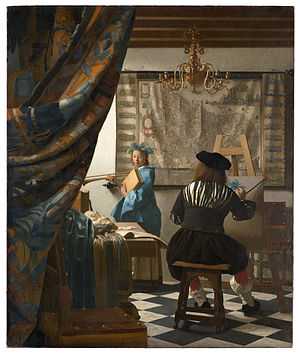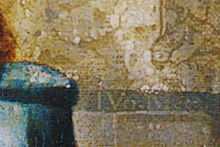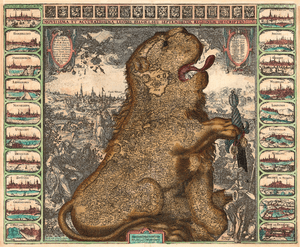The Art of Painting
 | |
| Artist | Johannes Vermeer |
|---|---|
| Year | 1665-1668 |
| Type | Oil on canvas |
| Dimensions | 130 cm × 110 cm (51 in × 43 in) |
| Location | Kunsthistorisches Museum, Vienna |
The Art of Painting, also known as The Allegory of Painting, or Painter in his Studio, is a 17th-century oil on canvas painting by Dutch painter Johannes Vermeer. Many art historians believe that it is an allegory of painting, hence the alternative title of the painting. After Vermeer's Christ in the House of Martha and Mary it is the largest work by the master. Its composition and iconography also make it the most complex Vermeer work of all.
This illusionistic painting is one of Vermeer's most famous. Svetlana Alpers describes it as unique and ambitious.[1] Walter Liedtke describes it "as a virtuoso display of the artist's power of invention and execution, staged in an imaginary version of his studio ..."[2] According to Albert Blankert "No other painting so flawlessly integrates naturalistic technique, brightly illuminated space, and a complexly integrated composition."[3]
The painting is owned by the Austrian Republic and is on display in the Kunsthistorisches Museum in Vienna.
Description

The painting depicts an artist painting a female subject in his studio, by a window, with a large map of the Low countries on the wall behind. Vermeer signed the painting on the map, behind the model's neck, but did not date it. Most experts believe it was done between 1665/1668, but some suggest the work could have been created as late as 1670-1675.[4] In 1663 Vermeer had been visited by Balthasar de Monconys, but had no painting to show. It was possibly done "in order to have an outstanding specimen of his art in his studio."[5] Vermeer obviously liked the painting; he never sold it during his lifetime. It stands as a kind of summary and assessment of what has been done.[6][7]
Elements

The painting has only two figures, the painter and his subject, a woman with downcast eyes. The painter is thought to be a self-portrait of the artist and according to Jean-Louis Vaudoyer the young girl could be his daughter.[9] The tapestry and the chair, both repoussoirs, lead the viewer into the painting. As in The Allegory of Faith the ceiling can be seen. Vermeer had a theoretical interest for painting. A number of the items, a plaster mask, perhaps representing the debate on paragone,[10] a piece of cloth, a folio and some leather on the table are thought to be somewhat out of place and uneasy to explain. The marble tiled floor and the splendid golden chandelier are examples of Vermeer's craftmanship and show his knowledge of perspective.
The map in the background is of the Seventeen Provinces of the Netherlands, flanked by 20 views of prominent Dutch cities.[11] In the top left two figures of the map two female figure can be seen; one bearing a cross-staff and compasses, while the other has a palette, brush and a city view in the hand.[12] Painted ships sail over the folds. It was published by Claes Janszoon Visscher in 1636. This map, but without the city views on the left and right can also be seen on paintings by Jacob Ochtervelt and Nicolaes Maes. Similar maps were found in the Bibliothèque Nationale in Paris [13] and in the Swedish Skokloster.[14]
Symbolism and allegory

Experts attribute symbols to various aspects of the painting. The subject is supposed to Fama,[15] Pictura [16] or Clio,[17] the Muse of History,[18] evidenced by her wearing a laurel wreath, holding a trumpet, possibly carrying a book by Herodotus or Thucydides, which matches the description in Cesare Ripa's 16th century book on emblems and personifications titled Iconologia.[19][20] However according to Ripa History should look back [21] and not down as in this painting. Following Vermeer's contemporary Gerard de Lairesse, interested in French Classicism and Ripa, there is another explanation; he mentions history and poetry as the main resources of a painter.[22][23] The female in a blue cloth and with a trumpet and the laurel could also be representing poetry.[24][25]
_-_WGA24678.jpg)
The double headed eagle, symbol of the Habsburg Holy Roman Empire, which possibly adorns the central golden chandelier, may represent the former rulers of the Low countries. The large map on the back wall has a prominent crease that divides the Seventeen Provinces between the north and south. (West is at the top of the map.) The crease symbolizes the division between the Dutch Republic to the north and southern provinces under Habsburg rule. The map shows the earlier political division between the Union of Utrecht to the north, and the loyal provinces to the south.[27]
A political interpretation of the map and the Habsburg eagle is unconvincing; they overlook other motives.[28] This interpretation might have appealed to Hitler who owned the painting during the war.[29] The map could suggest though that painting has brought fame to the Netherlands.[30]
Provenance
 | |
|
|
The painting is considered a work with significance for the artist because the painter himself did not part with it or sell it, even when he was in debt. In 1676, his widow Catharina bequeathed it to her mother, Maria Thins, in an attempt to avoid the sale of the painting to satisfy creditors.[31] The executor of Vermeer's estate, the famous Delft microscopist Anton van Leeuwenhoek, determined that the transferral of the work to the late painter's mother-in-law was illegal and according to John Michael Montias at least a curious transaction.[32] Most of his paintings were then sold in an auction at the Guild in Delft, 15 March 1677.[33] It is not known who bought the Art of Painting; it is believed it was Jacob Dissius.[34] The painting was owned by Gottfried van Swieten, and passed into the hands of his heirs.[35] In 1813 it was purchased for 50 florins by the Bohemian-Austrian Count Rudolf Czernin. It was placed on public display in the Czernin Museum in Vienna.
Until 1860, the painting was considered to be by Vermeer's contemporary Pieter de Hooch; Vermeer was little known until the late 19th century. Pieter's signature was even forged on the painting. It was at the intervention of the German art historian Gustav Friedrich Waagen that it was recognised as a Vermeer original.[36][37] In 1868 Thoré Bürger regarded this painting as his most interesting.
Nazi interest
In 1935 Count Jaromir Czernin had tried to sell the painting to Andrew W. Mellon, but the Austrian government prohibited the export of the painting.[38] After the annexation of Austria, Philipp Reemtsma with the help of Reichsmarschall Hermann Göring attempted to acquire the painting. The transaction to a private person was refused being cultural heritage.[39] It was finally acquired by Adolf Hitler for the collection of the Linzer Museum at a price of 1.82 million Reichsmark through his agent, Hans Posse on November 20, 1940.[40] The painting was rescued from a salt mine near Altaussee at the end of World War II in 1945, where it was preserved from Allied bombing raids, with other works of art. The painting was escorted to Vienna from Munich by Andrew Ritchie, chief of the Monuments, Fine Arts, and Archives program (MFA&A) for Austria, who transported it by locking himself and the painting in a train compartment.[41]
The Americans presented the painting to the Austrian Government in 1946, since the Czernin family were deemed to have sold it voluntarily, without undue force from Hitler. It is now the property of the Austrian Republic.
2009 request by heirs for restitution
In August 2009 a request was submitted by the heirs of the Czernin family to Austria's culture ministry for the return of the painting. A previous request was submitted in 1960s however it was "rejected on the grounds that the sale had been voluntary and the price had been adequate." A 1998 restitution law which pertains to public institutions has bolstered the family's legal position.[42][43]
See also
| Wikimedia Commons has media related to The Art of Painting by Johannes Vermeer. |
- Salvador Dalí refers to "The Art of Painting" in his own surrealistic painting The Ghost of Vermeer of Delft Which Can Be Used As a Table (1934). On Dalí's painting an the image of Vermeer, viewed from his back, re-created as a strange kind of table.
References
- ↑ Svetlana Alpers (1983) The Art of Description. Dutch Art in the Seventeenth Century, p. 119.
- ↑ Liedtke, Walter (2007). Dutch paintings in the Metropolitan Museum of Art. New York: Metropolitan Museum of Art. p. 893. ISBN 0-300-12028-1.
- ↑ A. Blankert (1978) Vermeer of Delft, p. 47-49. Oxford: Phaidon.
- ↑ Stokstad, Marilyn (1995). Art History. New York, NY: Harry N. Abrams, Inc., Publishers. p. 797. ISBN 0810927764.
- ↑ Vermeer and the Delft School, p. 396
- ↑ S. Alpers, p. 122.
- ↑ KHM on the "Art of Painting"
- ↑ Monumenta Cartographica Neerlandica Vol. VI
- ↑ Vermeer's Family Secrets: Genius, Discovery, and the Unknown Apprentice by Benjamin Binstock, p. 172.
- ↑ Essential Vermeer
- ↑ Brussel, Luxemburg, Gent, Bergen (Henegouwen), Amsterdam, Namen, Leeuwarden, Utrecht, Zutphen, en het Hof van Holland in Den Haag; en rechts Limburg, Nijmegen, Arras, Dordrecht, Middelburg, Antwerpen, Mechelen, Deventer, Groningen en het Hof van Brabant in Brussel.
- ↑ S. Alpers, p. 126.
- ↑ S. Alpers, p. 120.
- ↑ Monumenta Cartographica Neerlandica I (1986)
- ↑ Neurdenburg, E. (1942) Johannes Vermeer. Eenige opmerkingen naar aanleiding van de nieuwste studies over den Delftschen Vermeer. In: Oud-Holland 54, p. 70-71.
- ↑ Vermeer's Family Secrets: Genius, Discovery, and the Unknown Apprentice by Benjamin Binstock, p. 172.
- ↑ K.G. Hulten (1949) 'Zu Vermeers Atelierbild', In: Konsthistorisk Tidskrift, 18, p. 92.
- ↑ Iconologia, or, Moral emblems
- ↑ Iconologia di Cesare Ripa ...: divisa in tre libri, ne i quali si esprimono ... by Cesare Ripa
- ↑ Clio
- ↑ Iconologia di Cesare Ripa, p. 269
- ↑ Groot-Schilderboek (1712), p. 4, 6, 115, 121, 293
- ↑ Weber, Gregor J.M. (1991) Der Lobtopos des 'lebenden' Bildes: Jan Vos und sein "Zeege der Schilderkunst" von 1654, p. 61. ISBN 3-487-09604-8.
- ↑ Iconologia di Cesare Ripa ...: divisa in tre libri, ne i quali si esprimono ... by Cesare Ripa
- ↑ Vermeer's Family Secrets: Genius, Discovery, and the Unknown Apprentice by Benjamin Binstock, p. 175.
- ↑
- ↑ Vermeer: The Art of Painting, Exhibitions - NGA
- ↑ Vermeer and the Delft School, p. 396
- ↑ Vermeer's Family Secrets: Genius, Discovery, and the Unknown Apprentice by Benjamin Binstock, p. 182.
- ↑ Vermeer and the Delft School, p. 396
- ↑ Montias, J.M. (1989) Vermeer and his Milieu. A Web of Social History, p. 338-339.
- ↑ Vermeer and His Milieu: A Web of Social History by John M. Montias, p. 219, 229.
- ↑ Essential Vermeer
- ↑ http://alien.mur.at/rax/KUN_POL/KUNST/VERMEER/verhist1.html
- ↑ U.S. National Gallery
- ↑ Waagen, G.F. "Handbuch der Deutschen und Niederländischen Malerschulen". Stuttgart 1862, Bd II, p. 110.
- ↑ http://alien.mur.at/rax/KUN_POL/KUNST/VERMEER/verbio6.html
- ↑ Hitler and the European Art
- ↑ http://alien.mur.at/rax/KUN_POL/KUNST/VERMEER/verhist2.html
- ↑ Vermeer: The Art of Painting, The Painting's Afterlife - NGA
- ↑ Spirydowicz, K. (2010). Rescuing Europe's Cultural Heritage: The Role of the Allied Monuments Officers in World War II. Archaeology, Cultural Property, and the Military. L. Rush. Woodbridge, The Boydell Press: 15-27
- ↑ Heirs’ Claim for Hitler’s Vermeer Rejected by Austrian Panel
- ↑ KHM
_-_WGA24677.jpg)